Ventilation pipes are metal. Ventilation grates
Ventilation grilles are an important element of the air exchange system in the house. In addition to being decorative, they perform regulatory function, dispersing the directed air flows of the supply channels and adjusting their throughput. Grilles are made from various materials, but the most commonly used are galvanized sheet steel and durable plastic.
By design features, ventilation grilles are adjustable, unregulated and inertial. According to the place of installation, they are divided into external, internal and overflow.
Grilles for outdoor installation
External ventilation grilles are installed on the walls of houses from the side of the street to protect air ducts from dirt, leaves, rain or snow. They are made of sheet steel and are often equipped with a metal mesh to protect against the penetration of small rodents and insects into the house. Ventilation grills with check valve which allow airflow in only one direction.
Grilles for indoor installation
Plastic or metal ventilation grilles are installed inside the building to decorate duct openings. They can be equipped with movable shutters or deflectors to disperse the air flow. Internal grilles are small and have a neat, often decorative look.
Overflow ventilation grilles
They serve to ensure air exchange between rooms and are sometimes installed in interior doors. In order to maintain the light and sound insulation of the room, the louvres of the grilles are V-shaped.
Ventilation grilles in the store "Leroy Merlin"
The assortment of the Leroy Merlin store includes external and internal ventilation grilles made of metal and plastic. A variety of shapes, sizes and colors makes it possible to choose products for any needs: not only to ensure sufficient air exchange in the house, but also to successfully fit them into the interior of living rooms.
The process of installing a ventilation system is a basic and mandatory norm of sanitary and hygienic rules. The arrangement of such structures, as a rule, begins already at the design stage of construction work. It is possible to install pipes for ventilation of the house not only at the stage of construction, but also during the repair.
The main functional purpose of such systems is the supply of fresh air to the premises, the removal of waste masses. They are especially important when gas heating equipment is installed in the house. The absence of pipes for the ventilation system in the house is a potential threat to the health of all residents.
Air ducts, chimneys: installation features
The number of pipes and fittings required for ventilation is determined by the following factors:
- area and volume of the room;
- power of gas equipment, its purpose;
- features of the drafted construction project.
High-quality pipes for ventilation ensure reliable, safe, uninterrupted operation of the entire system. Hoods, pipes are installed in the kitchen, bathroom, saunas, rooms where there is a fireplace.
It is simply necessary to buy pipes for ventilation in order to guarantee the possibility of high-quality supply of fresh air to the premises. Today, the most common type of these products are PVC products. The main advantage of the material is durability, it is not affected by corrosion, resistant to temperature changes, deformations.
Depending on where the system will be installed, products of different diameters can be used in combination with a variety of connectors and corrugated elements. The efficiency and uninterrupted operation of the system will depend on the correctness of their choice.
Trading House "Elits" recommends the use of pipes for ventilation made of stainless steel. This option is more reliable and durable. We offer all kinds of shapes, sizes, diameters of products that can be used both for arranging residential premises and in industrial construction.
Pipes for ventilation: price, shapes and sizes
A modern manufacturer offers the consumer a huge variety of components for installing a ventilation system. Among this range, the following main forms are distinguished:
- round section;
- rectangular section;
- components of non-standard shape (combined, cut, etc.).
Pipes for ventilation, which you can buy in Moscow at the lowest prices in our company, with a round section, have the following advantages:
- they are not equipped with protruding parts, which makes it possible to install the system on a smaller area;
- make it possible to use a smaller insulating layer, which reduces the cost of the system installation process;
- low level of pollution.
Products with a square section are used when it is necessary to provide a large throughput. Such products have a more attractive appearance. Outdoor ventilation pipes are most often of this type.
We offer pipes for ventilation in Moscow of all the listed types and shapes. As for materials, our catalog includes products made of galvanized and stainless steel.
Galvanized steel is used when it is required to move air with a temperature not higher than 80 degrees. Otherwise, we recommend the use of heat-resistant stainless steel pipes. They easily cope with more difficult conditions, differ increased level durability in high temperature environments.
In the construction of public buildings, residential buildings or industrial premises, it is necessary to provide ventilation systems. This is due to sanitary and hygienic standards, safety standards and vital necessity. And to put it simply, when installing high-quality ventilation, there will be no unpleasant odors in the apartment, dampness and mold on the walls, and in industrial premises there will be no harmful impurities in the air. Ventilation pipes and fittings are a complex system for smoke removal and air purification in buildings where there is no natural ventilation, for underground structures and high-rise buildings. Specialists in design are engaged in the development and implementation of such systems.
Varieties of ventilation ducts
Plastic ventilation ducts are widely used in all types of premises. Pipes and fittings made of plastic provide the necessary level of tightness of the ventilation system, are not affected by moisture and corrosion. The smooth surface of the air duct reduces the noise level and creates the best conditions for the free passage of the flow of the calculated volume at the required speed. In addition, they do not need regular cleaning, therefore, the life of the ventilation system increases. However, with all their advantages, they can be used in systems with ambient temperatures up to +50°C. When installing plastic pipes, it is worth remembering that passage nodes in concrete or brick floors require the use of a steel sleeve, but the use of roofing felt or roofing felt is also allowed.
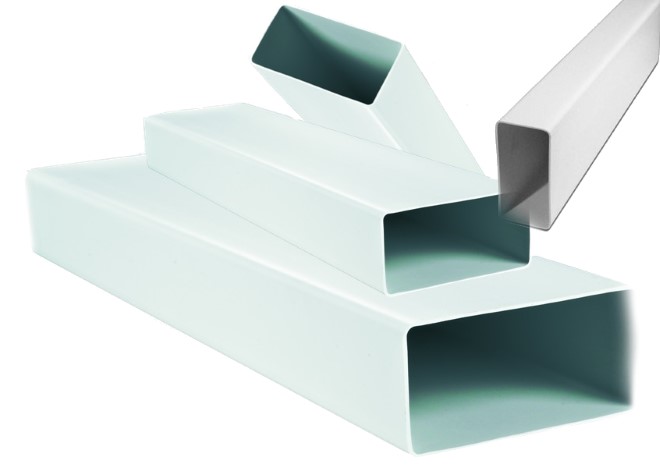
Plastic ventilation ducts
Flexible ducts are made of plastic or metal. Mainly used for exhaust ventilation with ambient temperatures from -30°C to +120°C. Ideal for laying in GKL boxes, fitting into any interior. The advantages include the possibility of using corrugated air ducts with a complex layout of the room, as well as ease of installation. Passage units for flexible ventilation ducts also require compliance with installation standards and the use of sleeves, and when laying in walls, additional insulation with a layer of concrete to avoid damage to the tightness. Exhaust pipes for ventilation are brought out through the shaft to the roof or roof.
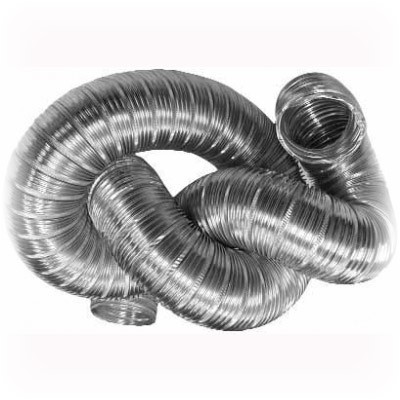
In industrial enterprises, metal rectangular or square ventilation boxes with numerous connecting elements are more often used. The node or joint of the connection is selected according to the design data.
The installation of steel ventilation ducts has a number of difficulties; the tightness of the system, the quality of sound insulation and its service life depend on the quality of welding or assembly of products. Rectangular or square ventilation ducts make more efficient use of space. However, often the inner corners of the ducts create air resistance and, in order to block the loss of air pressure, it is required to install additional electrical equipment.
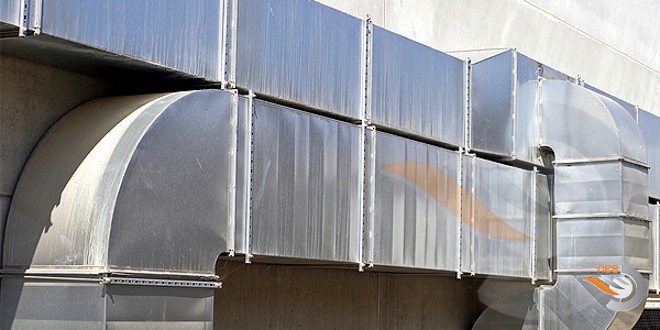
An example of the installation of metal ducts
For the exhaust air duct system, sandwich pipes are increasingly being used, which are made of connected two galvanized pipes filled with insulation between them.
The double-walled design of the chimneys ensures that there is no condensate in the pipe and fully complies with fire safety standards, since the insulation is made of refractory material. Double-walled galvanized pipes for ventilation are often installed outside the building, but can also be used for exhaust shafts.
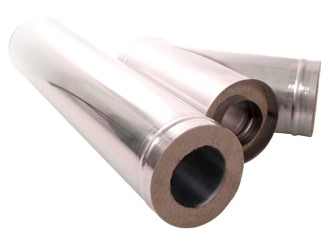
Single-wall pipes for chimneys are used indoors as an independent structure, which is connected to the main chimney, and as a sleeve in existing brick ventilation shafts. The metal chimney duct is made of corrosion-resistant stainless or galvanized steel. In the case of laying pipes in shaft channels, it is required to perform additional insulation of pipes from refractory material, fixing it with galvanizing.
Estimated data
To maintain human health, GOSTs, SANPiNs were developed, which regulate the indicators of the ventilation system. Ventilation performance begins with the calculation of air exchange and air distribution network, the choice of air distributors (grilles). To do this, you need to know the purpose and area of \u200b\u200bthe premises, as well as draw up a diagram for laying air ducts. Air diffusers are selected from catalogs according to air flow and noise level. Taking into account all the characteristics of the above calculations, a heater, a supply unit is selected.
Focusing on the normative data and dimensions of the premises, in order to create the necessary air exchange at a given rate, experts calculate the area or diameters of the air ducts. It must be understood that the cross-sectional area of the pipe directly affects the flow and speed of air in the duct. Reaching the required air velocity parameters, one should not forget about the sound insulation of flat or flexible metal ventilation ducts. Additional noise in corrugated piping or rigid ducts can be reduced by using sound absorbing sandwich board insulation, reducing the number of right angles, sharp bends and transitions from one pipe diameter to another.

When installing the pipeline of the ventilation system, taking into account the peculiarities of the environment of the room, operating conditions, round, square or flexible ventilation ducts made of plastic or steel structures are used. The cost of the ventilation system depends on the quality of the material used, on the thickness of the metal and the number of fittings. Welded black steel ducts will cost less than galvanized pipes. Shaped parts of plastic or metal pipelines allow you to assemble a ventilation and smoke exhaust route with numerous turns and intersections with other communications.
Briefly about the important
Summing up, we highlight for ourselves the main requirements for the design and installation of ventilation systems:
- Air ducts for ventilation can be made of plastic or metal, depending on the environment in which they are laid. The quality of the material does not affect the air circulation.
- When laying pipes in ceilings and walls, it is important to remember that the passage nodes must be protected by a steel sleeve or other wrapping material.
- The formula for calculating the cross section of the area of ventilation pipelines is used from reference books for design or SNiPs.
- Ventilation ducts (material and number of fittings) are used based on the type of buildings and the tasks set by the designers.
- Do not forget about soundproofing materials, as well as comply with the requirements for fixing air ducts to reduce additional noise in the room.
- Ventilation ducts can be laid not only indoors, but also in the channels of existing mines, as well as outside the building.
- A flexible duct is used when installing a complex ventilation line and for solving any design solutions, while flat ducts are used mainly for industrial premises.
Sheet metal ventilation elements are practical, durable and easy to install. Due to these and other properties, they are very widely used in industrial ventilation systems. Private homeowners tend to prefer other materials.
Read more about the advantages, disadvantages and features of the operation of metal ventilation ducts, pipes and fittings, read on.
Types of metal ventilation elements
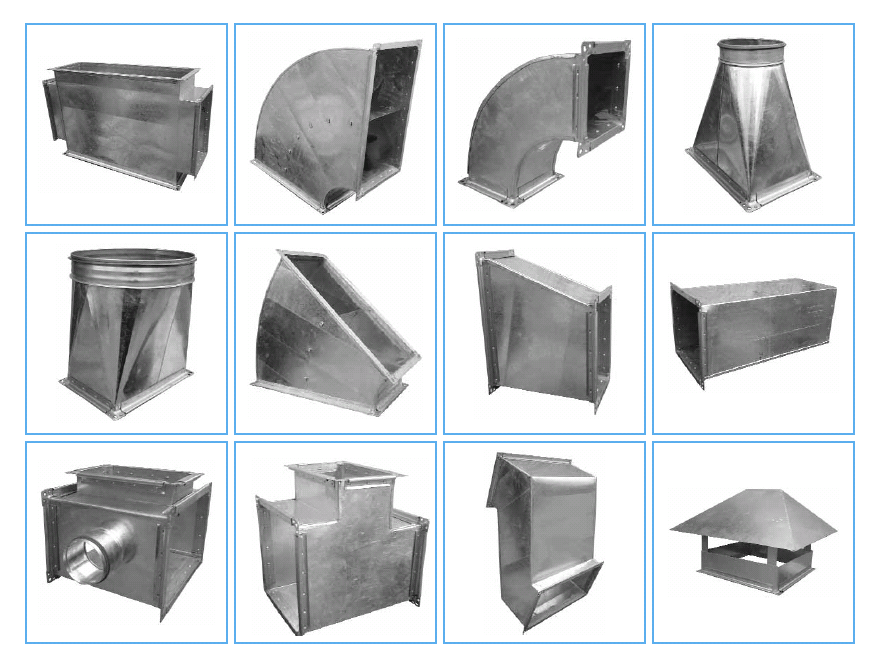
All main and auxiliary components for the ventilation system are made from metal:
- air ducts;
- nipple;
- umbrellas;
- tires;
- plugs;
- bends;
- adapters;
- tees;
- tie-in,
- metal ventilation grids and gratings.
Metal air ducts

Air ducts make up highways for transporting air flows. The outlets of the air ducts are covered with overhead metal ventilation grilles.
According to the shape of the section, they can be:
- rectangular;
- round.
Manufacturing technology:
- straight seam;
- spiral wound.
Straight seam metal ventilation ducts made from thin sheet steel. The edges of the whole sheet are fastened with folds (if the sheet thickness is not more than 1.4 mm) or by welding. The seam connection is not always tight enough and requires the use of additional material.
A welded joint is more laborious, but does not have such disadvantages. Longitudinal ducts are widely used to create short, straight sections.
They are produced in standard length and diameter of two tightness classes: "H" and "P". Class "H" or "normal" indicates the likelihood of small air leaks. Class "P" pipes are additionally sealed.
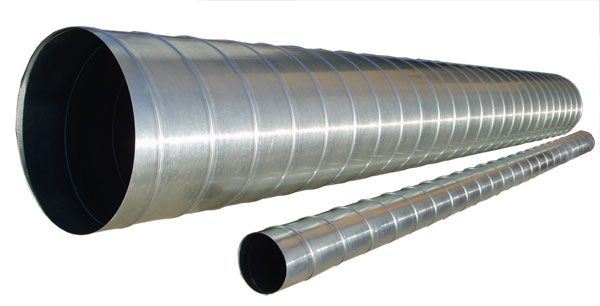
Spiral wound ducts made of a metal tape, which is curled into a tube using special equipment. A special rib gives additional rigidity to large-diameter pipes.
In residential premises, rectangular air ducts are more often used, which are easier to fit into the interior. However, such pipes create more air resistance. Therefore, in powerful industrial systems, preference is given to round ducts with better aerodynamic characteristics.
Flexible and semi-rigid ducts are often installed in small sections with many turns. Since the corrugation ribs create the greatest resistance to air movement.
Flexible metal ducts
![]()
The technology of their production is completely different from the types described above, and the material is aluminum foil.
Flexible metal ventilation ducts can be:
- isolated;
- uninsulated.
They are a spiral frame made of rigid steel wire, on which several layers of laminated lavsan film and aluminum foil are worn. Insulated flexible metal sheets are wrapped in a layer of mineral wool 3 cm thick, which is covered with an additional layer of foil on top.
Metal shaped products
Shaped metal products allow you to connect air ducts of various diameters and sections, perform turns and a variety of wiring. With the help of umbrellas or metal ventilation grilles, conclusions are made to the outside. And metal ventilation grids protect the air ducts from the penetration of small animals and debris.
Shaped parts produce a wide variety of types and shapes. Often, the main costs during the installation of ventilation fall not on air ducts, but on shaped products. They can be rectangular or round, of various diameters and are selected for air ducts.
To assemble a standard duct network, you will need the following minimum set of fittings:
- bends at 45 and 90 degrees;
- duck;
- nipple;
- tee;
- tie-in;
- plug.
Metal ventilation grilles are superimposed on the outlet of the duct from the side of the street. External metal ventilation grilles can be equipped with a louvered system. In winter or idle periods, the air duct is reliably covered from debris and dust. Such devices must be installed in large facilities.
In residential buildings, it is enough to cover the exit with a metal mesh for ventilation. Unpleasant odors and dust are removed from the toilet or kitchen through a metal ventilation mesh.
Sometimes the exit of the ventilation pipes is placed in the floor (for example), in some industries or in saunas and is covered with a metal ventilation grill for the floor. Most often, a metal grate is built into the floor to create an area high blood pressure in work areas.
Metals for ventilation elements
Metal ducts for ventilation are made from corrosion-resistant sheets:
- stainless steel;
- Cink Steel;
- aluminum.
Metal pipes for stainless steel ventilation very durable and meet the highest sanitary and hygienic requirements:
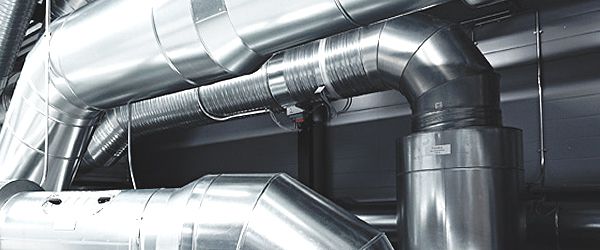
- withstand up to +500 degrees Celsius;
- they are not inhabited by fungus and mold;
- resistant to direct fire;
- resistant to moisture;
- resistant to aggressive environments.
Used metal steel hospitals and clinics, schools, as well as in industries with high radiation levels, high temperatures and humidity.
Galvanized metal ventilation pipes are made from cold-rolled steel with a sheet thickness of 0.5 to 1.25 mm, less often a hot-rolled sheet is not thicker than 0.9 mm. In the second case, the steel is additionally treated with a primer.
- withstand up to +85 degrees Celsius;
- resistant to air humidity up to 60%;
- biologically stable;
- relatively inexpensive;
- easily assembled into a structure, leaky areas are replaced;
- have a low weight.
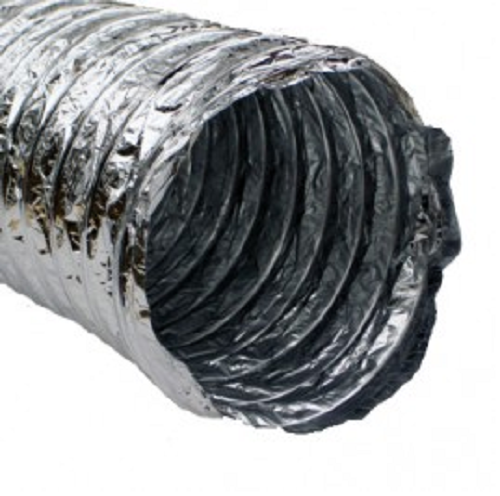
Due to these properties, galvanized metal ventilation pipes are often installed in warehouses and dry industries.
Between themselves, metal ventilation ducts are connected by flanges or nipples.
Aluminum ducts are flexible or semi-rigid. They are made of aluminum foil of different thicknesses (from 0.08 to 0.12 mm). The main advantage of metal aluminum ducts for ventilation is the ability to bend them at any angle:
- withstand temperatures up to +135 degrees (flexible) and up to +300 degrees (semi-rigid);
- resistant to aggressive environments and ultraviolet (semi-rigid);
- can be installed in catering rooms, dryers and ironers;
- do not need grounding.
Semi-rigid ducts can be installed outdoors.
Aluminum metal ventilation ducts are practical, lightweight and inexpensive. They are perfectly bent, attached to each other with a triple lock. A flexible metal duct for ventilation can be compressed and stretched several times. In a compressed state, flexible and semi-rigid air ducts are convenient to transport and store, their length is 50 cm. When stretched, it reaches 3 meters.
Rules for the installation of ventilation elements
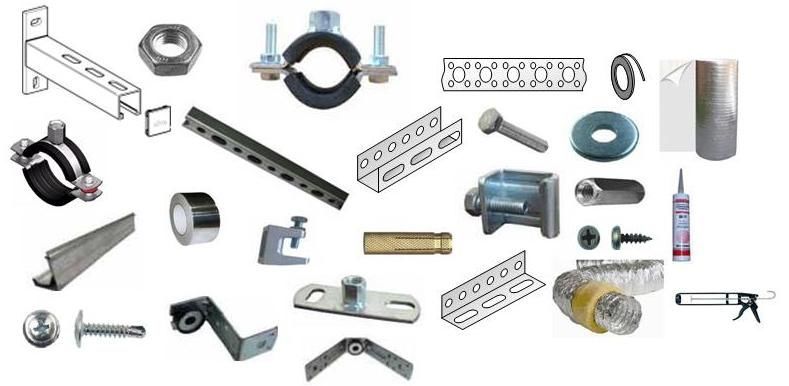
Before starting the installation of the ventilation system, it is necessary to examine the room and select the best method of fastening.
For fastening metal ducts use:
- clamps;
- hairpins;
- corners;
- bolts and nuts.
Sometimes you have to resort to welding.
Installation of flexible metal pipes has its own rules:
- To reduce pressure losses inside the pipe, they are mounted only in a stretched state;
- It is more convenient to cut off excess pieces immediately;
- It is more expedient to use wide brackets that do not pinch the pipe;
- To pass through the walls, one-piece adapters or metal sleeves must be used.
Distribute suspension points using the following rules:
- on bends, the bending radius must be less than the diameter of the duct;
- sagging of no more than 5 centimeters per linear meter is allowed;
- when installing the pipe vertically, there should be a distance of 1 - 1.8 meters between the fasteners.
Connection of air ducts and shaped parts of ventilation to each other
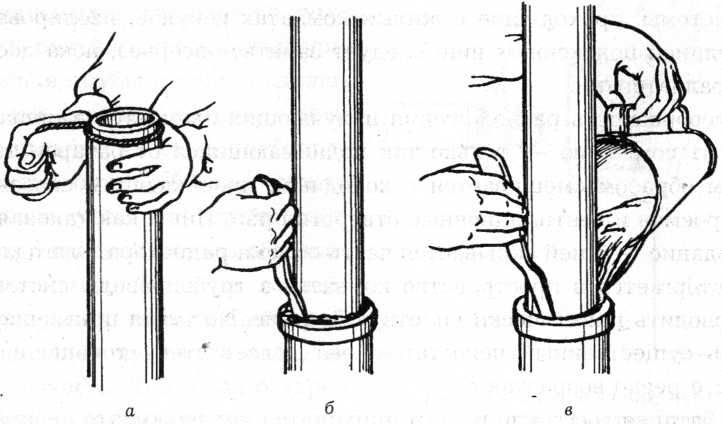
To connect elements of a circular cross section, the following are used:
- flange mounting. To ensure a tight seam, the flanges are fastened with a flange. Flange holes must remain free;
- bandage mount rarely used, mainly in hazardous industries. It provides complete sealing. First, the ends of the air ducts are bent, then a bandage is put on. It is filled with a chemically neutral substance or ordinary sealant. The technology is simple and inexpensive, but the manufacture of bandages is quite expensive. Therefore, it is not widely used;
- Coupling or nipple. Available with or without rubber seal. If there is no gum, sealant treatment is required during installation. Special attention should be paid to its composition and quality when placing the system outside the building or in aggressive environments;
- Trumpet- the simplest and most widely used connection. The smaller diameter pipe is inserted into the larger one.
Provided like this:
- the air duct is made in the form of a cone;
- one end of the duct is slightly narrowed, the other is widened.
To connect rectangular elements are used:
- Flanges that are fastened with rivets or spot welding. The second option is simpler and more common, although it leads to rapid burnout of the pipe at the welding points;
- Tires are the most common type of fastening in general exchange systems. The sides are interconnected with corner inserts. On air ducts of large diameters (200 mm and more), a tightening element is certainly mounted.
When connecting rectangular ventilation pipes, it is imperative to seal the corners. Connections are laid with tapes from:
- monolithic rubber;
- foam rubber;
- polymer mastic rope.
Cons of metal ventilation elements
- More expensive than plastic;
- During manufacture, roughness may appear on the internal surfaces, increasing air resistance;
- The relatively large weight of the structure, due to which it is necessary to use special fasteners;
- Susceptibility to corrosion of air ducts made of "black" steel;
- aerodynamic noise.
Metal ventilation from the outer grille to the air ducts has made some room on the market for polymer products that do not have the listed disadvantages. However, there is no better material for powerful air exchange systems than metal today.
This is how straight-seam air ducts are made on the most modern machines:
Comfortable working conditions are the basis for the well-being of employees. To ensure comfortable working conditions for all employees, it is necessary to correctly distribute the lighting of the room, as well as equip the building's air conditioning system.
A galvanized pipe for ventilation is best suited for such purposes. Such products are produced using the hot rolling technique.
Galvanized air ducts for ventilation are characterized by:
- small weight;
- low cost;
- durability;
- ease of maintenance and installation of products.
The galvanized pipe for ventilation is perfect for arranging air ducts, chimneys and even for transporting working fluids of any temperature.
Arrangement of ventilation with galvanized steel pipes
Modern air ducts are divided into several types:
- hard;
- semi-rigid;
- flexible.
To date, the most popular are rigid systems, for the arrangement of which galvanized ventilation boxes and pipes are used.
It should be noted that ventilation made of galvanized steel is the most technologically advanced, does not lend itself to corrosion, is resistant to sunlight and is able to move even aggressive gases.
In addition, galvanized ventilation boxes and pipes are characterized by versatility and durability.
We will help you with the purchase of galvanized pipes for ventilation systems
If you decide to buy galvanized pipes for ventilation, better places than an online store site you will not find! We offer you a wide range of tin products for arranging air duct systems at the lowest prices.
In addition, on our website you can find galvanized ventilation ducts, the price of which is affordable. You can place an order in any way convenient for you (by phone, or by filling out an application on the website). Delivery is carried out to all regions of the Russian Federation.
